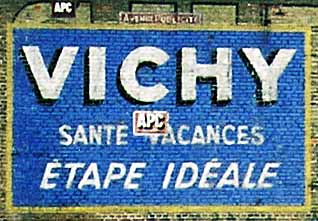
Shortly after we moved to France, we noticed that whenever we visited the supermarket, there would always be someone with a shopping trolley packed to the gunnels with bottled water. I was really surprised by this, and started to wonder if there was something wrong with the drinking water which, to me, tastes like any other tap water I have drunk in Britain or elsewhere in Europe. At work, there are numerous opportunities to buy water. You can buy about ten different varieties, some flavoured, in the vending machines or large bottles of various types of mineral water at the coffee bar or in the restaurant.
According to 'Le Guide du Buveur d'Eau' by Emmanuelle Evina (Solar, 1997) the French drank 5,5 billion litres of bottled water in 1996, enough for 110 litres per person, making them the world's no.1 water drinkers. France produces an enormous range of bottled waters of varying types. The book mentioned above lists more than 90 different bottled waters coming from all over France, but particularly from the Puy de Dome area, the Ardèche, the Cevennes, the Pyrenees, the Vosges, Haute-Savoie and the Côtes-d'Armor. In short, anywhere mountainous or rugged.
The origin of the 'water is good for you' fad began way back in Celtic times when springs, notably warm, mineral springs became centres of cult worship. The Romans, when they invaded, built their baths and temples next to these spas and in a sense adopted the cults, seeing them as a good way of keeping the locals in line. "Do as we tell you or we won't let you get your life-giving water", that kind of thing.
The 'spa' centres built by the Romans have essentially existed until the present day. The medicinal properties of spa 'mineral waters' have been recognised for hundreds of years, originally being prescribed to the aristicracy and the rich, and gradually trickling down to the common man. There was something of a boom in bottled water that began at the end of the 19th Century when investigations by scientists started to show that illnesses such as cholera and typhoid came from drinking water wells. Pasteur is quoted as saying: "We drink 90% of our illnesses". While in London, people were staying fit and well by drinking large quantities of ale, typically ten pints or so a day, in France they turned to bottled water. The growth in consumption of water, now including spring water (eau de source) has continued to grow to the present day, supported by the advertising campaigns of major food producers such as Nestle and Danone.
The drinking of water is prescribed for urinary, metabolic, digestive and rheumatic disorders. The various trace elements present in the water include the cations: calcium, magnesium, sodium, potassium, iron, fluorine, selenium, silicium, and the anions: bicarbonate, chloride, nitrate, phosphorate and sulphate. According to my book, lack of these elements, which are necessary for the proper functioning of enzymes in the body can cause problems as diverse as muscle cramps and memory loss.
Against this, however, we have to take the statement of the World Health Organisation on their website which says: Although certain mineral waters may be useful in providing essential micro-nutrients, such as calcium, WHO is unaware of any convincing evidence to support the beneficial effects of consuming such mineral waters. If there really isn't that much benefit in bottled water, then that's an awful lot of plastic bottles made for nothing.
When drinking water you should look out for the following tastes: acid, bitter, salty (due to sulphates and chlorides), sugary, salty and bitter (magnesium), alkaline, metallic (iron, copper), chlorinated, mandarin (due to traces of hydrocarbon), chemical, earthy (chalk), mouldy cork (pesticides).
The characteristics of the water is closely linked to the geology of the regions it comes from. The 'Grande Source du Volcan' brand for example comes from the foot of the Aizic volcano in the Ardèche and is naturally sparkling (gazeuse in French) but weakly mineralised. Others come from the alps, such as the 'eau de reference' brand which is Evian and contains higher quantites of calcium bicarbonate coming from dissolution of limestone. Very mineralised waters such as those from Vichy may emerge from the ground at up to 40 degrees C and are not generally drunk in large amounts. When they are sodic, they may have laxative properties...
To some extent, all this interest in the medicinal properties of mineral waters must go back to the same root as the French hyponchondriac tendecies that I have mentioned before, but also, France is very much a country of 'la terre'. It is bounded on several sides by other countries and it is a large landmass where you can often be rather far from the sea. In addition, it is a rather dry country which gives natural springs a rather precious quality. If you have ever watched the film 'Jean de Florette' (after the novel of Marcel Pagnol) you will know that the position of a spring provides the central context around which the whole plot revolves.
Some springs, such as Lourdes, retain a healing and spiritual context, reminding us of the importance of water in religious rituals, such as baptisms. Which reminds me of the poem called 'Water' by Philip Larkin:
"If I were called in
To construct a religion
I should make use of water..."
He makes us think of water's pure and purifying character: 'a devout drench' and ends with an image of water's ability to gather light as it also gathers people towards it:
"And I should raise in the East
A glass of water
Where any angled light
Would congregate endlessly."
He doesn't say whether it is mineral water or spring water. Knowing Larkin, I suspect it would be tap water. It would seem, however, that Larkins' new faith, in which he makes no mention of God, but instead invokes large doses of water, has apparently been taken up in France.
1 comment:
that was very interesting. thanks
Post a Comment